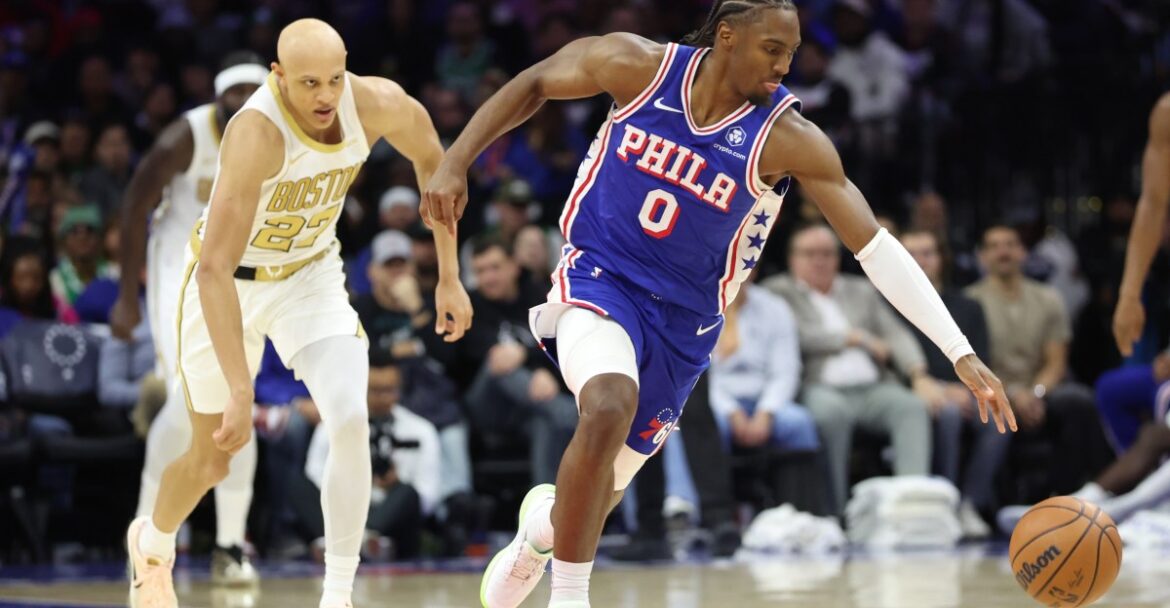In last night’s 102-100 loss to the Philadelphia 76ers, the Celtics reached clutch minutes for a seventh time this season, tied for the fourth most 5-under-5 situations in the league.
Of their five clutch losses, two of which have now come at the hands of the Sixers with their three matchups decided by a total of four points, three have come down to a possession where the defense got the initial stop but couldn’t grab the defensive rebound.
Those rebounding woes have persisted this season, but boy can this team work to get the initial stop, and as a self-described gap-year optimist, it’s hard not to come away from this game without at least a few positive things to say specifically about Jordan Walsh’s excellent defensive performance.
Walsh has now seen his number called for clutch moments in two straight games, and in both instances, he’s shown people exactly what they need to see as he faces a make-or-break season in Boston.
“I think it says a lot about the trust this organization has in me,” Walsh said. “Obviously Joe, but also the trust the guys have in me as well, getting me involved, trusting that if I’m guarding the best player, we want me on there and he’s gonna get a stop.”
Walsh, like Josh Minott and Hugo Gonzalez before him, has been given his shot to impress within the wing rotation, and he’s giving Joe Mazzulla reasons to look for him down the bench, and it starts with that defensive aptitude and builds further through his progress as an offensive contributor.
“Just the effort that he plays with on the defensive end,” Mazzulla said. “The different ways that he can play-make on the offensive end whether it’s screening, offensive rebounding, knocking down open shots, which he’s done. So he’s just getting better and better, gotta keep it up.”
Walsh played nearly every second of clutch time on Tuesday night, only checking out on Boston’s final possession when they inserted Anfernee Simons into the game. In that appearance, Walsh’s primary task was defending an All-Star scorer in Tyrese Maxey, stopping him on two clear-outs down the stretch.
Walsh ultimately spent a total of six minutes defending Maxey, holding him to 1-of-9 shooting, a pair of free throws and two assists. In clutch time, Maxey was 1-for-3 shooting with a pair of free throws for 4 points. In total, the Sixers were 5-of-17 when Walsh was the primary defender.
Seeing the way Walsh defended Maxey prior to clutch time gave them all the evidence they needed to keep that matchup a priority. After the game, Walsh acknowledged an emphasis of understanding player tendencies and figuring out how to place a scorer of Maxey’s caliber in uncomfortable situations.
Maxey, an elite pull-up shooter off screens and a deadly-space creator through his step-back game, took shots early in this night that reeked of befuddlement, like this isolation possession in the second quarter where Walsh perfectly shadowed him every step of the way to the free throw line, snuffed out a pivot foot spin and matadored Maxey’s scoop layup.
Most importantly in that clip is the fact that Walsh stays with him without being overly physical. It’s mostly body defending with his hands straight up. It’s an extremely impressive defensive stop.
When Maxey wanted to get into his off-screen game, Walsh continued to disrupt without playing too physical on the ball. This quarter-ending possession is a straight-forward give-and-go, with V.J. Edgecombe setting the screen for Maxey to fire off a last-second shot. Not exactly the most intimidating screen-setter in the world, but Edgecombe’s screen is so close to the sideline that it doesn’t give Walsh much time to react, yet he smoothly turns the corner and provides an excellent contest on what would have been a clean look.
Here, Walsh has to defend a double-drag set by Edgecombe and Andre Drummond, and while it’s not as smooth a maneuver evading the screen like in the previous clip, Walsh’s recovery from the initial Edgecombe bump and the ensuing contact with Drummond is pretty impressive. When he recovers, he has the benefit of a well-positioned drop from Luka Garza, who is placed close enough to both the rolling Drummond and ball-handling Maxey to contest either option, and because of Garza’s positioning and Walsh’s recovery, it’s two players on both sides of Maxey that are able to strongly contest an off-the-mark floater.
Having seen all the ways he impacted Maxey’s comfort level prior to the game’s clutch minutes, let’s look at the three shots Walsh defended in those final five minutes. Walsh gets a hand up to contest on every single one of these, though Maxey does start with this tough pull-up jumper where Walsh again stays attached on the drive. Minutes later, Maxey weasels his way to the exact same spot on the floor, but simply has nowhere to go when Walsh doesn’t bite on his up-fake. With no dribble and a late shot clock, this is Maxey at his most uncomfortable, and it’s a desperation fadeaway that hits the back of the iron.
With under a minute left and in desperate need of a stop, this entire clip is an amalgamation of everything we just saw. If there was one clip you had to take away from this game in regards to Jordan Walsh’s place in the rotation, it is this one right here. In one possession, he’s defending a clear-out, a relocation with a screen denial and a late drive on one of the league’s craftiest scorers, and he passes every test on the way to a crucial stop. Not only are his feet keeping pace with Maxey’s, but he has a hand up in his face for nearly the entire possession and especially when he knows the shot clock’s running down and a shot has to come off Maxey’s hands.
It is perfect defense, and exactly the kind of sequence fans needed to see from Walsh in his third NBA season.
